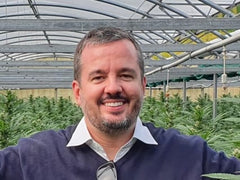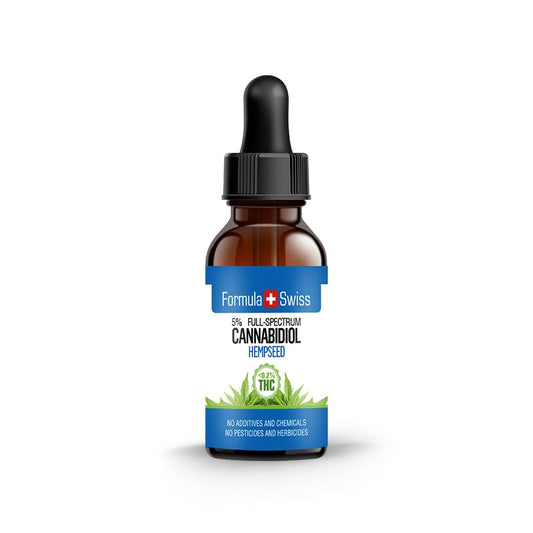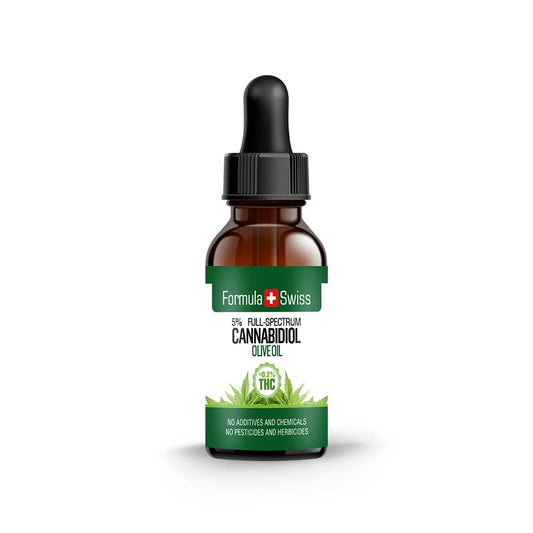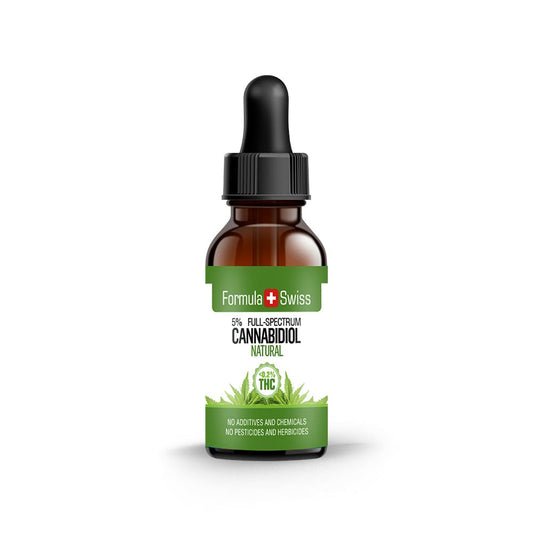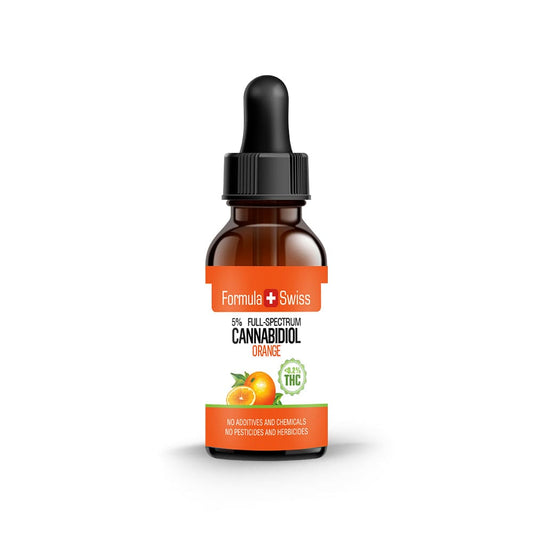Delta-9 THC, short for delta-9 tetrahydrocannabinol, is the main psychoactive compound in the cannabis plant. It’s what most people think of when they hear “THC,” and it’s responsible for the effects commonly linked to cannabis use. It occurs naturally in the plant and interacts with specific receptors in the brain, which is why it can change how people feel or perceive things.
In my years working hands-on with Formula Swiss hemp and CBD production, I’ve come to see delta-9 THC as more than just a headline ingredient. There’s a lot of misunderstanding around it. While it's often talked about for its ability to cause a "high," there’s more to it, its presence in the plant, how it's formed during growth and processing, and how different laws classify or regulate it.
This article is meant to explain what delta-9 THC actually is, based on real experience with cultivation, compliance, and product development—not to promote it, but to give a clearer picture of why it matters and what it does.
Prefer watching over reading? This video covers the key points from the article:
Save up to 30% when you order your CBD oil today
Key takeaways
- Delta-9 THC is one of the most prominent and studied cannabinoids found in the cannabis plant.
- It is known for producing psychoactive effects due to its interaction with cannabinoid receptors in the brain.
- The concentration of delta-9 THC varies between cannabis strains and is often increased through selective cultivation.
- Delta-9 THC differs chemically from other THC isomers such as delta-8 and delta-10, which also occur in cannabis.
This article is provided for informational purposes only and does not relate to any of the products available in our webshop. For more information, please see our full disclaimer.
An Introduction to delta-9 THC
Delta 9 tetrahydrocannabinol, or delta 9 THC, is the primary psychoactive part of cannabis. It is known for producing a notable effect on perception and awareness. In recent years, there has been a growing amount of academic interest in THC, contributing to a better understanding of its characteristics.
Defining delta-9 tetrahydrocannabinol
Delta-9 THC is a naturally occurring compound in the cannabis plant called a cannabinoid. According to a review published in Scientific World Journal, cannabinoids interact with cannabinoid receptors in the brain and other areas of the body, influencing how certain chemical signals are processed.
The chemical structure of delta-8 THC
Delta-8 THC is a structural isomer of delta-9 THC, meaning both compounds share the same molecular formula but differ slightly in the arrangement of atoms. The key difference is the position of a double bond in the carbon chain—on the eighth carbon for delta-8, compared to the ninth for delta-9.

This minor distinction gives each compound unique characteristics in terms of chemical behaviour and how they are classified in various contexts.
The slight shift in molecular structure also influences delta-8 THC’s physical properties. It tends to be more stable under certain storage and processing conditions, which can make it a preferred option in some manufacturing settings.
While it occurs naturally in cannabis in small amounts, delta-8 is often produced through isomerisation of other cannabinoids, such as CBD, to obtain higher concentrations.
The significance of cannabis research
Research into cannabis and its components, including THC, has increased steadily. This work has broadened scientific knowledge about cannabinoids and their interaction with biological systems. The outcomes have contributed to more precise methods for studying cannabis-derived compounds.
| Cannabinoid | Key areas of interest | Associated effects |
|---|---|---|
| Delta 9 THC | Neurological interaction, behavioural research | Altered perception, changes in awareness |
| CBD | Receptor modulation, ongoing scientific analysis | Non-psychoactive |
Order and get up to 30% off your CBD oil
The science behind delta 9 THC
Understanding delta 9 THC's chemical profile is key. Delta 9-tetrahydrocannabinol, or THC, is known for its psychoactive properties and plays a significant role in the botanical characteristics of cannabis.
The amount of THC in cannabis has changed significantly over time. Analysing THC levels provides valuable information regarding the properties and potential implications of various cannabis-derived materials.

As more regions introduce legal frameworks for cannabis-related applications, ensuring rigorous assessment and quality control is more important than ever.
This trend is relevant when evaluating both the intensified effects and the associated considerations of higher THC concentrations. It underscores the importance of ongoing monitoring and detailed analysis.
Authorities and professionals must employ scientific assessments to maintain safety standards and further understanding of cannabinoid-based materials.
What is THC (Tetrahydrocannabinol)?
Historical use of cannabis and THC
The story of cannabis and THC goes back thousands of years. It's deeply connected to many ancient societies. Looking into this cannabis history, we see its key role in daily life and ancient medicine. The journey of cannabis from a wild plant to a cultivated one is truly interesting.
Early cannabis cultivation
In its early history, cannabis cultivation extended beyond mere agriculture—it played a meaningful role in the daily life and economies of ancient civilisations. Various regions developed distinct cultivation methods based on local conditions, priorities, and uses, including a focus on characteristics such as resin production and fibre quality.
While some growers selectively bred plants for traits like higher THC content, others prioritised sturdier stalks for textile use or seeds for nutritional applications.

This adaptability allowed cannabis to support a broad range of uses. It became a resource for producing items such as clothing, ropes, paper, and oil-based goods. The plant’s versatility and resilience made it a cornerstone of traditional farming systems across many cultures.
THC's role in traditional practices
When examining historical references to THC, its role in ancient practices is often mentioned. Various cultures regarded it for its distinctive properties and incorporated it into rituals and other applications.
The table below outlines how different ancient civilisations approached the use of cannabis. It highlights the widespread historical presence of the plant across regions and eras.
| Civilisation | Period | Context of use |
|---|---|---|
| Ancient Egypt | 2,000 BC | Referenced in ceremonial records |
| Ancient China | 2,700 BC | Included in botanical texts |
| Ancient India | 1,500 BC | Linked to spiritual and ritual contexts |
These historical references illustrate the longstanding presence of cannabis in human societies. While the nature of its applications has varied, its cultural significance has been noted across time periods.
Order CBD oil now and save as much as 30%
Delta 9 THC vs CBD: Understanding the differences
In reviewing information on cannabinoids, notable differences emerge between delta 9 THC and CBD. Delta 9 THC is known for its psychoactive influence, altering perception and mood. It is often noted for this property.
CBD does not have psychoactive effects. It is frequently selected by individuals interested in cannabinoid research without the changes in awareness associated with THC. Scientific studies continue to examine its interaction with various systems.

Research publications offer insight into how these compounds interact differently within the body. The distinct ways in which THC and CBD influence neural receptors are of particular interest in ongoing analysis.
Psychoactive properties
THC and CBD affect cognitive processes differently. THC can lead to elevated mood or heightened sensory awareness, though it may also cause discomfort in some contexts. This is linked to its affinity with certain brain receptors.
Which cannabinoids produce a psychoactive effect?
Scientific studies on THC and CBD
Studies have explored areas of interest regarding THC and CBD. THC is being examined in contexts related to neurological interaction, while CBD is under investigation for its influence on neural activity and emotional regulation.
| Compound | Primary effects | Key research focus |
|---|---|---|
| Delta 9 THC | Psychoactive effects | Neurological response, behavioural impact |
| CBD | Non-psychoactive | Neuroreceptor modulation, emotional stability |
Gaining clarity on the distinctions between THC and CBD supports informed decision-making. Research must continue to examine these compounds separately, to expand knowledge responsibly.
How Delta 9 THC works in the human body
To understand how delta 9 THC interacts with the body, it is important to examine its relationship with the endocannabinoid system. This system plays a role in maintaining internal regulation and is linked to various physiological responses.
Interaction with the Endocannabinoid System
Delta-9 THC binds to cannabinoid receptors found throughout the body, primarily CB1 and CB2, according to a study published in the journal Pharmacological Research.
These interactions contribute to its influence on processes such as mood, perception, and memory. The endocannabinoid system is recognised for its involvement in various signalling pathways.

Through its interaction with this system, delta 9 THC can influence how certain signals are processed, which helps explain its psychoactive properties and the attention it has received in scientific studies.
The Endocannabinoid System (ECS)
Effects on the brain and body
Delta-9 THC interacts with receptors in the brain, which may contribute to changes in perception and cognition. These features are often examined to their psychoactive characteristics.
Its activity is not limited to the brain, as it also interacts with receptors found in other parts of the body. These responses remain an active topic of research across various scientific fields.
The impact of delta 9 THC on public health
The talk about delta 9 THC and its effect on public health is growing. As THC rules change to keep us safe, we must keep looking at new scientific findings. These findings help us make smart choices.
Regulating THC to protect public health
To keep our communities safe, we need strong and flexible THC rules. Careful monitoring, backed by solid science, helps create safe guidelines. These rules aim to stop misuse while allowing THC's medical benefits.
Scientific evidence on THC and public safety
Research on THC's health impact shows varied results. A 2020 review published in Adolescent Health, Medicine and Therapeutics indicates that controlled use may offer benefits, but excessive use can be harmful, particularly for adolescents. This evidence contributes to shaping laws that aim to balance safety with potential medical applications.
It is important for THC regulations to reflect current scientific findings in order to reduce associated risks. Keeping laws aligned with new research and societal changes remains essential.
Global perspectives on delta 9 THC and cannabis policy
Examining cannabis policies worldwide highlights the varied approaches to managing delta-9 THC. Each country implements its own framework, influenced by cultural factors, political objectives, and historical background. This leads to a wide spectrum of practices, ranging from strict restrictions to structured access models.

Observing how different governments create and enforce these laws shows the influence of social values and practical concerns. Some countries aim to reduce unregulated use through structured systems, while others maintain firm restrictions. These approaches offer lessons about what may or may not work in different settings.
The variety in global cannabis laws reflects the need for flexible policies that can respond to new information, shifting public attitudes, and changing priorities. Studying these systems helps deepen our understanding of the regulatory landscape surrounding delta-9 THC.
Personal perspective
Looking ahead, cannabis research is expected to expand our understanding of delta-9 Tetrahydrocannabinol. Changes in laws often create new opportunities for scientists to study cannabinoids more closely. Public interest in THC’s properties continues to support this momentum.
Although funding challenges remain, the commitment to exploring cannabis and its components is strong. Continued investment in research is important for advancing knowledge and informing future decisions related to delta-9 THC.
One potential direction is the development of more targeted applications, shaped by individual factors. Achieving this depends on detailed scientific work and policies that stay current with findings. Ongoing conversations between researchers, legal experts, and the public are essential for meaningful progress.
The next phase of cannabis research is focused on building a clearer understanding. Through consistent inquiry and study, our grasp of delta-9 THC will improve. With combined effort from scientists, policymakers, and communities, we can move toward better-informed approaches to its use and regulation.
Don’t miss out—save up to 30% when you purchase CBD oil today
Frequently asked questions
What is delta 9 THC?
Delta-9 Tetrahydrocannabinol (delta-9 THC) is the primary psychoactive component in cannabis. It interacts with the body's endocannabinoid system, influencing mental and physical responses.
Why is cannabis research significant?
Research into cannabis helps improve understanding of THC's properties and its broader implications. It also informs legal frameworks and regulatory decisions.
How has delta 9 THC been used historically?
Historically, cannabis has been cultivated for various purposes, including textiles and traditional practices. Its psychoactive properties have been recognised in numerous cultural contexts over time.
What are the differences between delta 9 THC and CBD?
Delta-9 THC is known for its psychoactive effects, while CBD is non-intoxicating. They interact differently with the body, leading to a variety of applications across regulated product categories.
What methods are used to apply delta 9 THC?
Delta-9 THC can be introduced via a variety of methods, including inhalation and topical application. Preferences depend on legal availability, product format, and local regulations.
How does regulating delta 9 THC protect public interest?
Regulation helps maintain standards by overseeing product quality and limiting access through authorised channels. This contributes to orderly market practices and risk management.
Why is scientific evidence on THC and public policy important?
Scientific research supports informed decision-making. It guides law development and provides a factual basis for setting appropriate controls.
How do global perspectives on cannabis policy differ?
Global cannabis policies vary widely. Some nations prohibit all forms, while others allow regulated use for industrial or specific regulated purposes. These differences reflect unique cultural, legal, and policy considerations.
What future directions might cannabis research take?
Future research may focus on plant genetics, production methods, and the broader societal impact of cannabinoids. Continued study is expected to support regulatory clarity and deeper understanding.
What is THC (Tetrahydrocannabinol)?


